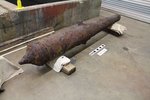SPANISH FORT — An old cannon of unknown age and origin will soon be on display at Spanish Fort City Hall and will be joined by several other antique artillery pieces recently donated to the city, officials said.
This item is available in full to subscribers.
Please log in to continue |


SPANISH FORT — An old cannon of unknown age and origin will soon be on display at Spanish Fort City Hall and will be joined by several other antique artillery pieces recently donated to the city, officials said.
The original cannon was found at a site in Spanish Fort in 2017. For several years, it was being restored and conserved at Florida Bureau of Archaeological Resources in Tallahassee. Mayor Mike McMillan said the piece is now back in Spanish Fort and work will begin soon to build a display area for the artifact.
He said four other old cannons have also been presented to the city and will also be put on display at city hall. Those guns were found in Jamaica but are from the same 18th-century colonial period when the Spanish fortifications for which the city was named were built.
"We're now cannon rich," McMillan said. "We've gotten an additional four cannons. We'll be able to fortify the fort real soon with cannons everywhere."
The city is working to collect artifacts from throughout Spanish Fort's history to be put on display in a community museum planned at city hall, McMillan said.
Shawn Holland, a local amateur historian who took part in the discovery and removal of the original cannon in 2017, said that piece should be displayed inside where it can be protected from vandalism and the elements.
"This is a valuable piece of our history," she said. "It's not a yard ornament. It deserves respect."
Holland said that while the cannon was treated and restored in Florida, the centuries-old iron artifact is still susceptible to deterioration and damage and should not be left outside.
The iron cannon is too deteriorated to determine when or where it was built, according to Jessica Burns who studied the cannon while it was being treated in Florida.
Spanish Fort was the site of several battles and fortifications during the Civil War and American Revolution. The city's name comes from a fort built by Spanish colonial forces who were fighting the British during the Revolution around 1780.
Holland said she believes that the cannon gun may date to Spanish activity in the area during an earlier period. The Spanish explorer Tristan de Luna established a settlement in Pensacola in 1559. She said de Luna landed horses on the Eastern Shore to be sent to Pensacola on at least one occasion and is likely to have set up an outpost near Spanish Fort.
"It's at the head of the largest bay on the Gulf and where five rivers come down," she said. "This spot is the highest ground where you could see anything coming up the bay or down from the delta. This is where you would locate a fort or a mission."
She said the gun is very similar to photographs that she has seen of cannons in Ireland that were described as being very old when they were placed at their present site in the 1640s.
The gun is 8.75 feet long, according to bureau reports. It has a muzzle diameter of 3.75 inches and is 41 inches in circumference at the base. The report listed the age of the cannon as undetermined.